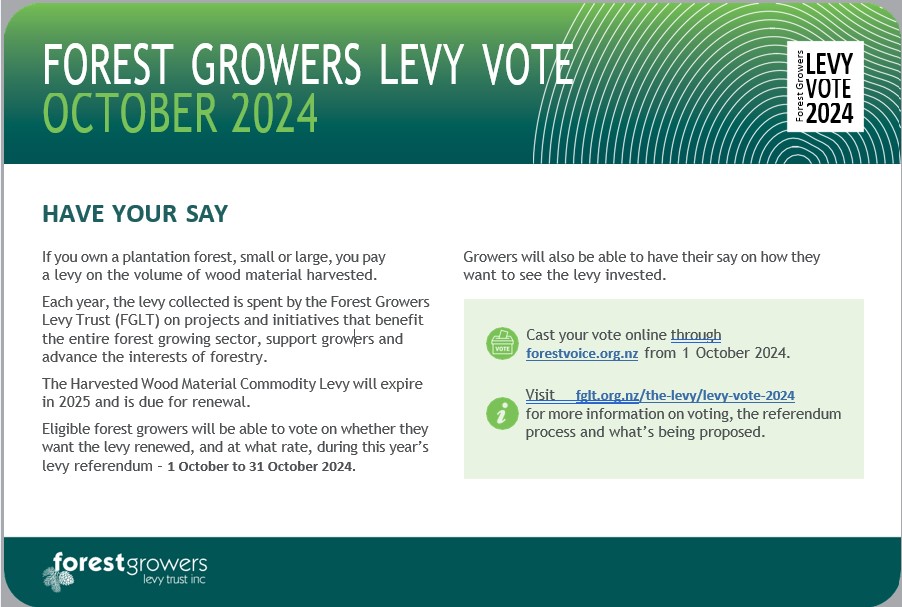The Forest Growers’ Levy is vital for supporting forestry’s growth and resilience
Eliabeth Heeg, New Zealand Tree Grower August 2024.
The Commodities Levy Act framework provides a mechanism for primary sectors to raise funds and invest in projects and activities which improve that particular sector. Forestry’s levy, the Harvested Wood Material Commodity Levy, was established in 2013. It has become vital for building forestry’s resilience, working on regulatory pressures and supporting growers to adapt to a rapidly changing environment.
All plantation forest owners, whether small or large, pay a levy which is collected when the trees are harvested at a rate of 33 cents a tonne of harvested wood material. The Forest Growers’ Levy Trust acts as a custodian of the levy money, ensuring it is appropriately spent in areas such as research and development, biosecurity, promotion, health and safety to advance the interests of the forest growing sector.The money raised by the levy benefits all the forest growers, for example raising $10 million in 2023.
Research and development
The largest portfolio of the work programme, comprising nearly 60 per cent, is forestry research and development.This has produced significant gains for small-scale and large-scale forest growers. For every levy dollar invested in the forestry research and development programme, an additional $2.50 has been obtained. As a result of this work, tree genetics have been enhanced, and pests and diseases, which threaten the health of the forests, have been managed.
Developing harvesting technology for more efficient, safer and economical ways for growers to operate, continues to be a focus. Other areas have included –
- Silviculture and tree improvement, for which research aims to develop better forest management practices and improve tree genetics for higher yields, disease resistance and overall forest health
- Resilient forests, by studying the environmental effects of forestry operations and developing sustainable practices to ensure long-term ecological health of forests
- Innovation and technology, with funding directed towards developing new technology and innovative practices which can improve efficiency and productivity within the forestry sector.
For the environment, the Forest Growers’ Levy Trust has promoted sustainable forest management practices using guidelines, training programmes and workshops.These initiatives help implement best practices that balance economic, environmental and social aims.
The levy has provided specific support to farm foresters with resource funding towards some publications and small-scale forestry projects, education programmes and workshops. Significant progress has been made in improving forestry’s workforce safety.With levy co- funding, the work of the Forest Industry Safety Council has seen forestry’s fatality rate decrease significantly, and a 25 per cent decrease in the number of forestry workers requiring more than five days off work due to injury.
Levy renewal
If the levy were to lapse, much of this momentum would be lost and a new levy would be difficult to reinstate.The Harvested Wood Material Commodity Levy is up for renewal every six years, subject to the sector signalling majority support for its renewal.
Eligible forest growers will have the opportunity to vote on whether they want the levy renewed for a further six years and at what rate, during this year’s Forest Growers’ Levy vote, from 1 October to 31 October this year.
If the levy is successfully renewed, plantation forest growers will have the opportunity to provide feedback on where they want to see levy money invested during the next levy order period.The Forest Growers’ Levy Trust is proposing to increase the levy rate from 33 cents a tonne of harvested wood to a band of between 40 cents and 65 cents for the next levy order period which would be from November 2025 to November 2031.
A levy rate of 40 cents has been identified as the minimum rate required to effect sufficient change and produce the benefits forest growers are seeking.The proposed new levy rate will enable the Forest Growers’ Levy Trust help plantation forest growers to improve their practices, protect their investments and enhance the overall sustainability and competitiveness of New Zealand’s forestry.
Levy vote consultation began in April, with more than 20 regional roadshows and a series of online webinars for those growers who were unable to attend in person. Information on the upcoming levy vote will continue to be made available to forest growers using email, newsletters, print information but primarily the Forest Growers’ Levy Trust website – www.fglt.org.nz Voting criteria, the voting process and a list of frequently asked questions are available on this website and in the Have your say information booklet. Please contact admin@fglt.org.nz if you would like a hard copy of this booklet mailed out to you.
Eligible forest growers will be able to place their vote online from 1 October to 31 October 2024 using the independent voting website forestvoice.org.nz.
The Forest Growers’ Levy Trust will publicise the provisional outcome of the vote on receipt of the results from Research NZ. Renewal of the levy will be subject to final approval by the Minister of Forestry.
Elizabeth Heeg is the Chief Executive of the Forest Growers’ Levy Trust.

 Farm Forestry New Zealand
Farm Forestry New Zealand